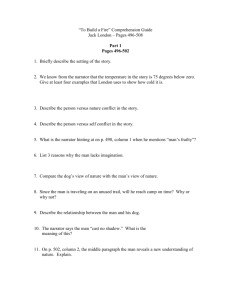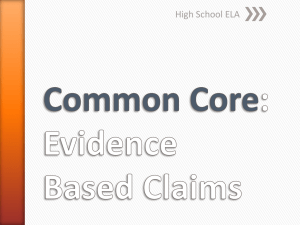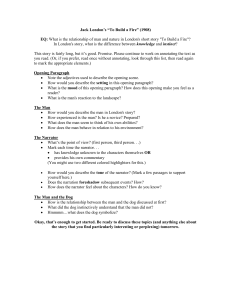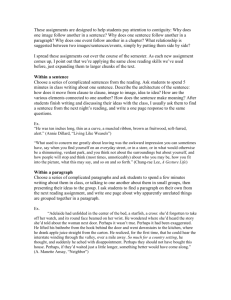ELA 3 4
advertisement
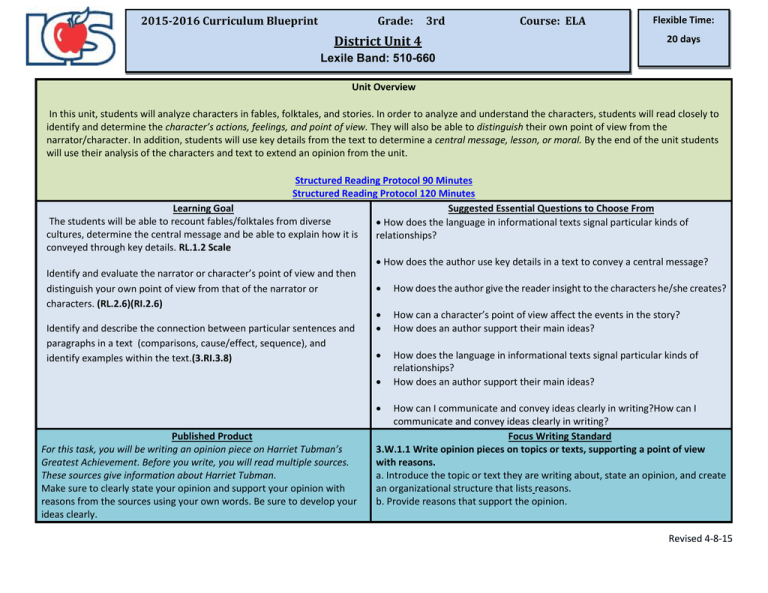
2015-2016 Curriculum Blueprint Grade: 3rd District Unit 4 Course: ELA Flexible Time: 20 days Lexile Band: 510-660 Unit Overview In this unit, students will analyze characters in fables, folktales, and stories. In order to analyze and understand the characters, students will read closely to identify and determine the character’s actions, feelings, and point of view. They will also be able to distinguish their own point of view from the narrator/character. In addition, students will use key details from the text to determine a central message, lesson, or moral. By the end of the unit students will use their analysis of the characters and text to extend an opinion from the unit. Structured Reading Protocol 90 Minutes Structured Reading Protocol 120 Minutes Learning Goal Suggested Essential Questions to Choose From The students will be able to recount fables/folktales from diverse How does the language in informational texts signal particular kinds of cultures, determine the central message and be able to explain how it is relationships? conveyed through key details. RL.1.2 Scale How does the author use key details in a text to convey a central message? Identify and evaluate the narrator or character’s point of view and then How does the author give the reader insight to the characters he/she creates? distinguish your own point of view from that of the narrator or characters. (RL.2.6)(RI.2.6) How can a character’s point of view affect the events in the story? Identify and describe the connection between particular sentences and How does an author support their main ideas? paragraphs in a text (comparisons, cause/effect, sequence), and How does the language in informational texts signal particular kinds of identify examples within the text.(3.RI.3.8) relationships? How does an author support their main ideas? Published Product For this task, you will be writing an opinion piece on Harriet Tubman’s Greatest Achievement. Before you write, you will read multiple sources. These sources give information about Harriet Tubman. Make sure to clearly state your opinion and support your opinion with reasons from the sources using your own words. Be sure to develop your ideas clearly. How can I communicate and convey ideas clearly in writing?How can I communicate and convey ideas clearly in writing? Focus Writing Standard 3.W.1.1 Write opinion pieces on topics or texts, supporting a point of view with reasons. a. Introduce the topic or text they are writing about, state an opinion, and create an organizational structure that lists reasons. b. Provide reasons that support the opinion. Revised 4-8-15 Use link: http://connected.mcgrawhill.com/media/repository/private_data/DOC/50000644/29/68.pdf pgs 32-51 as reference and information sources Teachers may have to cut and paste ..it is from the “Countdown to Common Core Assessment: Smarter Balanced Performance Tasks.” c. Use linking words and phrases (e.g., because, therefore, since, for example) to connect opinion and reasons. d. Provide a concluding statement or section. Recursive Standards to be Embedded in Instruction * McGraw Hill Wonders Series may be used to teach the following: Foundational Skills, Speaking and Listening, Writing and Language, Grammar, and Spelling Recursive Standards The above link is a listing of standards that should be addressed multiple times throughout the year while instructing the weekly standards. Reading Standards 3.RL.1.2 (DOK 2) Recount stories, including fables, folktales, and myths from diverse cultures; Determine the central message, lesson, or moral and explain how it is conveyed though key details in the text • Recount fables, folktales, and myths from diverse cultures • Determine the moral in a fable, lesson in a folktale, central message in a myth • Determine how the central message, lesson, or moral is conveyed 2nd: Recount stories, including fables and folktales from diverse cultures, and determine their central message, lesson, or moral 4th:Determine a theme of a story, drama, or poem from details in the text; Summarize the text 3.RI.1.2 (DOK 2) Determine the main idea of a text; recount the key details and explain how they support the main idea. • Determine the main idea of a text • Recount key details of a text • Explain how the key details support the main idea 2nd: Identify the main topic of a multiparagraph texts as well as the focus of specific paragraphs within the text 4th: Determine the main idea of a text and explain how it is supported by key details; Summarize the text 3.RL.2.6 (DOK 3) Distinguish their own point of view from that of the narrator or those of the character • Recognize own point of view • Identify the narrator’s point of view • Identify the character’s point of view • Compare own point of view to the narrator’s or the character’s point of view • Contrast own point of view to the narrator’s or the character’s point of view 2nd: Acknowledge differences in the points of view of characters, including by speaking in a different voice for each character when reading dialogue aloud. 4th: Compare and contrast the point of view from which different stories are narrated, including the difference between first- and third-person narrations. Revised 4-8-15 3.RI.2.6 (DOK 3) Distinguish their own point of view from that of the author of the text • Recognize own point of view • Identify the narrator’s point of view • Identify the character’s point of view • Compare/contrast own point of view to the narrator’s or the character’s point of view 2nd: Identify the main purpose of a text, including what the author wants to answer, explain, or describe. 4th: Compare and contrast a firsthand and secondhand account of the same event or topic; describe the differences in focus and the information provided. 3.RI.3.8 (DOK 2) Describe the logical connection between particular sentences and paragraphs in a text (e.g. comparison, cause/effect, first/second/third in a sequence) • Define sentence • Explain the purpose of a paragraph • Identify structure(s) of paragraphs • Explain how sentences logically connect to a paragraph’s meaning • Determine how a text is organized 2nd: Describe how reasons support specific points the author makes in a text 4th: Explain how an author uses reasons and evidence to support particular points in a text Speaking and Listening Standards 3.SL.1.3 Ask and answer questions about information from a speaker, offering appropriate elaboration and detail. Language Standards 3.L.2.3 (DOK 3) Use knowledge of language and its conventions when writing, speaking, reading, or listening. a. Choose words and phrases for effect. b. Recognize and observe differences between the conventions of spoken and written Standard English. 3.L.3.6 (DOK 1) Acquire and use accurately conversational, general academic, and domain specific words and phrases as found in grade appropriate texts, including those that signal spatial and temporal relationships (e.g., After dinner that night we went looking for them). Suggested Literary Texts *Depending on readability of text, Interactive Read-Alouds may be utilized (refer to Higher Order Questions to ensure deeper comprehension) Recommended Paired Texts Literary Tasks LDC 4-5 Template Tasks 3.RL.1.2 (DOK 2) After reading, _________________, write a constructed response in which you provide 2 to 3 textual examples of how the ____________ thinking and actions convey the lesson of the story. Revised 4-8-15 Week 1 : Intro to Historical Figures: Using Pearson My World SS Book: - Susan B. Anthony page 168 - Thurgood Marshall page 170 - Mary McCloud Bethune page 176 - Cesar Chavez page 178 - Clara Barton page 180 - Martin Luther King, Jr. 216 3.RI.3.8 (DOK2) After reading _______________, have a collaborative discussion to explain the reason the author included the paragraph on pg ________. 3.RL.2.6 (DOK 3) In _____________, we learn ________’s point of view about checking books out at the library (page 225). Write an extended response to explain ____________ point of view and how it compares to your own point of view regarding the ______________! 3. RI.3.8 (DOK 2) Using a thinking map/organizer, the students will determine how the author connects the three sections of the story ___________. Use the signal words to show how ideas and events are connected by the order in which they happen. SAFARI MONTAGE The Civil Rights Movement in America Week 2 : Historical Fiction - When Mariah Sang - Take A Stand, Rosa Parks - Story of Ruby Bridges Week 3-4: Harriet Tubman DBQ 3.RI.1.2 (DOK2) After reading __________, determine the main idea and the key details. Explain how the key details support the main idea. Use a graphic organizer and write a constructed paragraph. 3.RL.1.2 (DOK 2) Create a sequencing map to recount key specific details from the folktale _________________. Using the map write a constructed response in which you determine the lesson of the folktale and include key specific details to support your discussion. 3.RL.1.2 (DOK2) After reading _________________ students will paraphrase the details of the story to determine the theme. In a graphic organizer, recount the key details and then have students illustrate the theme of the selection. Week 5 Published Product (This time can also be used for remediation of skills and completion of extended resources and optional texts) Audio/Multimedia Presentations to Address RI.3.7 and SL.1.2 All video clips are located on Safari Montage. Your login is the same as your district login. Tools and Resources for Finding Optional Texts Science Texts: When applicable Revised 4-8-15 Social Studies Texts: When applicable Document-Based Questions (DBQs) This link will direct you to login to Moodle to access all DBQ documents login/password is your district login/password NEWSELA NEWSELA is an innovative way to build reading comprehension with nonfiction that's always relevant: daily news. ebscohost Under this link, Searchasaurus is the recommended search to use login/password is lakecounty lexile.com lexile.com serves as a tool to assist teachers with verifying reading sources for curriculum support. Tools to measure text complexity (Vetting a text) *Students should interact with the suggested/optional texts multiple times to master the three focus reading standards within this unit. PLC’s should collaborate to determine the order of instruction and strategies that support the learning goal. *The tasks provided are a sampling therefore additional tasks would be required to ensure adequate practice and deepening of knowledge to ensure mastery of the focus standards. Cold Read Assessment: Ready Florida pages 16-18 Higher Order Questions Link to Webb’s DOK Guide *Question stems should be utilized to create text dependent questions to encourage close reading, speaking, listening, and writing throughout the unit. Revised 4-8-15 R.1.2 *What examples/key details can you find to support the idea that __? *What is the most important point/idea in __? * Recount the detail you felt was most important and why. *What facts/ideas support the main idea? *What is the main idea of __? *How do the details of the text support the main idea? What lesson(s) can be learned from the folktale? *What is the moral of the fable? *What is the central message of the myth? How did you determine the central message? *What key details from the text support the lesson/moral/central message? *How did the author use details to convey the lesson/moral/central message? R.2.6 * What is __( narrator, character) point of view of/on __? How do you know? How does it compare to your point of view on __? *What similarities/ differences exist between __ view on __ and your view on __? *Why do you feel __ about __? Why do you think __ (person) feels __ about __? *Select the part of the story that is told from the point of view of someone other than the main character. *From which character’s point of view is the story told? * What is __(narrator, character) point of view of/on __? How do you know? How does it compare to your point of view on __? *What similarities/ differences exist between __ view on __ and your view on __? *Why do you feel __ about __? Why do you think __ (person) feels __ about __? * Which part of the story is told from the point of view of someone other than the main character? *From which character’s point of view is the story told? R.3.8 *How is the text organized? *Why did the author include paragraph __? *How is paragraph _ similar to/different from paragraph __? *How does the author develop his/her idea across paragraphs? *Why does the author include __ (this sentence) in this paragraph? *What connection does the sentence __ have to the paragraph? *Would __ (sentence) fit into paragraph __? Explain your reasoning. *What does the author do to help the reader understand __? *How does the author support the point __ in paragraph __? *Which of the following descriptions explains the relationship between paragraphs ___? Additional Resources & Links Marzano Proficiency Scales Bank Writing Rubric – Informative/Explanatory Writing Rubric - Opinion FSA Test Item Specifications 3rd Grade ELA Test Item Specifications 4th Grade ELA Test Item Specifications 5th Grade ELA Test Item Specifications Revised 4-8-15



